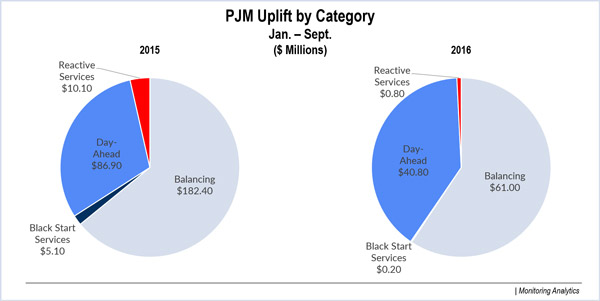By Michael Brooks
WASHINGTON — FERC last week proposed regulations intended to reduce uplift, allocate it more accurately and increase transparency (RM17-2).
The Notice of Proposed Rulemaking — the fourth issued by the commission in its ongoing price formation initiative — is premised on a preliminary finding that current RTO and ISO practices regarding reporting of uplift payments and operator-initiated commitments are unjust and unreasonable.
“The allocation of uplift costs should, to the extent possible, encourage behavior that will reduce the need for uplift-creating actions and avoid discouraging market participant behavior that lowers total production costs (i.e., enhances efficiency),” the commission said.
Lack of Transparency
“The lack of transparency regarding uplift and operator-initiated commitments, which can cause uplift, hinders market participants’ ability to plan and efficiently respond to system needs,” the commission said. “Market participants may lack the information necessary to evaluate the need for and value of additional investment, such as transmission upgrades or new generation. Also, without sufficient transparency, market participants may not be able to assess each RTO’s/ISO’s operator-initiated commitment practices and raise any issues of concern through the stakeholder process.”
Generators receive uplift payments when their production costs exceed their energy and ancillary services revenues. Last week’s order focuses on one of the main causes of uplift: deviations between the day-ahead and real-time market that can force operators to commit additional units. This can result from generators delivering less energy in real time than their day-ahead offers or real-time loads exceeding expectations.
Although all RTOs and ISOs use some form of beneficiary pays or cost-causation principles to allocate uplift, their methods “vary significantly, both in terms of granularity and the exemption of certain types of transactions,” the commission said. “The definition of what precisely constitutes a deviation also varies across RTOs/ISOs.”
Some RTOs also fail to consider how deviations affect uplift costs. “Deviations from day-ahead market schedules that create the need for additional resource commitments in real-time tend to increase real-time uplift costs. On the other hand, deviations can also contribute to the convergence of the day-ahead and real-time markets,” the commission said.
“Allocating costs to deviations that did not cause the costs to be incurred may inappropriately penalize certain types of transactions that are beneficial to price formation,” the Office of Energy Policy and Innovation’s Stanley Wolf said in a presentation at Thursday’s commission meeting, which was closed to the public because of concerns about disruptions by anti-pipeline activists.
‘Helping’ and ‘Harming’ Deviations
The NOPR requires RTOs and ISOs to separate uplift costs assigned to deviations into at least two categories based on their causes: congestion management or systemwide capacity, a catch-all for any other deviations made to meet the system’s energy needs. The commission said categorization would ensure the costs are allocated more precisely to the participants that caused the uplift. The NOPR gives RTOs flexibility to create additional categories.
Grid operators would also be required to distinguish between deviations that help or harm their systems. Generators would be assigned uplift costs based on the net of their “harming” deviations — the total amount of deviations minus their “helping” deviations.
FERC said that any actions generators take in response to dispatch instructions should not be considered deviations. Also excluded would be transactions economically evaluated by RTOs in real time, such as the coordinated transaction scheduling between PJM and its neighbors NYISO and MISO.
The commissioners said they were inclined to exclude instructed deviations from the “help” category but asked for stakeholders’ comments on the issue.
RTO Requirements
The commission also proposed several requirements to increase transparency into uplift cost allocation and the decision-making of grid operators, noting that while all RTOs and ISOs release some information, “there is significant variation in the timing, granularity and types of data released.”
RTOs and ISOs would be required to:
- Report total uplift payments for each transmission zone, separated by day and uplift category;
- Report total uplift payments for each resource monthly;
- Report megawatts of operator-initiated commitments in or near real time and after the close of the day-ahead market, broken out by transmission zone and the reason for the commitment; and
- Define in their tariffs the transmission constraint penalty factors, how those factors can set LMPs and the process by which they can be changed. Transmission constraint penalty factors are the values at which an RTO will relax the flow-based limit on a transmission element to relieve a constraint rather than re-dispatch resources.
“The proposed transparency reforms will help market participants understand the operational constraints on the system, plan and efficiently respond to system needs, and evaluate the need for and value of additional investment,” FERC said.
“While uplift is not constituting a large proportion of total costs and is unavoidable to some extent, I think RTO/ISO stakeholders and the commission should strive to minimize uplift when and where possible because uplift is unhedgeable, lacks transparency and, if not allocated properly, can encourage inefficient behavior,” Chairman Norman Bay said.
The NOPR only addresses uplift costs incurred because of deviations. RTOs may also pay uplift for reliability reasons, such as stand-by costs, or inaccurate load forecasting.
“We note that the commission is not proposing to require RTOs/ISOs to allocate any amount of uplift costs to deviations; rather we are simply proposing reforms to uplift cost allocation to deviations to the extent an RTO/ISO chooses to allocate some uplift costs to deviations,” FERC said.
Comments on the NOPR are due no later than 60 days after its publication in the Federal Register.
Previous orders in the commission’s price formation initiative concerned fast-start resources, shortage pricing and the alignment of settlement and dispatch intervals and a doubling of the “hard” energy offer cap. (See FERC: Let Fast-Start Resources Set Prices.)





